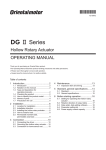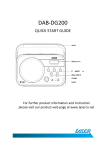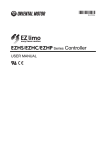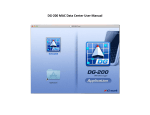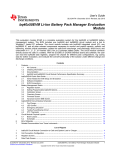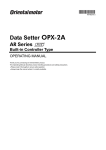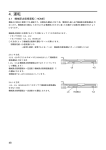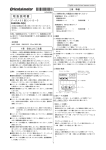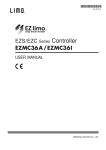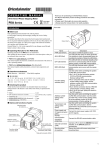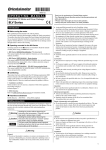Download 2 Safety precautions
Transcript
HL-14053 Hollow Rotary Actuators DGⅡSeries Actuator Edition OPERATING MANUAL Thank you for purchasing an Oriental Motor product. This operating manual describes product handling procedures and safety precautions. • Please read it thoroughly to ensure safe operation. • Always keep the manual where it is readily available. Table of contents 1 Introduction ........................................ 2 2 Safety precautions ............................. 5 3 Precautions for use ............................ 8 4 Installation ........................................ 11 4.1 Location for installation..........................11 4.2 Installation direction...............................11 4.3 How to install the actuator .....................11 4.4 Securing the load to the output table.... 13 4.5 Permissible moment load and permissible thrust load ......................... 14 4.6 How to install the home-sensor set ...... 15 5 Connection ....................................... 19 5.1 How to connect to the driver................. 19 5.2 Grounding the actuator(For DG85,DG130 and DG200 only)......... 19 6 Inspection......................................... 20 7 General specifications...................... 21 1 Introduction 1 Introduction Before use Only qualified personnel should work with the product. Use the product correctly after thoroughly reading the section 2 “Safety precautions” on page 5. The product described in this manual has been designed and manufactured for use in general industrial machinery, and must not be used for any other purpose. Oriental Motor Co., Ltd. is not responsible for any damage caused through failure to observe this warning. Operating Manuals for the DGⅡ Series Operating manuals for the DGⅡ Series are listed below. The DGⅡ Series USER MANUAL is the same one as the AR Series.Use the product correctly after thoroughly reading the operating manuals. • DGⅡ Series Actuator Edition OPERATING MANUAL (this document) This manual explains the actuator functions as well as installation method and others. • Driver for Motorized Actuator OPERATING MANUAL (This manual comes with the product) This manual explains the driver functions as well as installation method and others. • AR Series USER MANUAL (Download from the Oriental Motor Website Downloads Page) This manual explains the motor and driver functions, the installation and connection method, as well as troubleshooting and others. This manual does not come with the product. For details, contact your nearest Oriental Motor sales office. CE Marking The actuator being combined with the AC power input type driver is affixed the CE Marking under the EN standard (Low Voltage Directive). • Applicable Standards EN 60034-1、EN 60034-5、EN 60664-1 • Installation conditions (EN Standard) This product is used as a component to be installed within another device. Overvoltage category:Ⅱ Pollution degree: 2 Protection against electric shock: Class Ⅰ • For Low Voltage Directive This product is designed and manufactured to be installed within another device. Securely ground the protective earth terminal of the actuator. Hazardous substances RoHS (Directive −2− 2002/95/EC 27Jan.2003) compliant 1 Introduction Checking the product Verify that the items listed below are included. Report any missing or damaged items to the branch or sales office from which you purchased the product. • Actuator..................................1 unit • Operating manual ...................1 copy Names and functions of parts • DG60 Load mounting pin holes (two locations) Output table Gear mechanism Load mounting screw holes (six locations) Positioning pin hole Positioning pin hole Pilot Mounting hole (four locations) Sensor mounting bracket fixed screw holes (two locations) Motor parts Motor cable −3− 1 Introduction • DG85, DG130, DG200 The following figure illustrates the DG130 type with an electromagnetic brake. Load mounting pin holes (two locations) Output table Load mounting screw holes (six locations) Mounting hole (four locations) Positioning pin holes (two locations) Shielded plate fixed screw holes (two locations) Sensor mounting bracket fixed screw holes (two locations) Gear mechanism Motor parts Electromagnetic brake Protective Earth Terminal Electromagnetic brake cable −4− Motor cable 2 2 Safety precautions Safety precautions The precautions described below are intended to prevent danger or injury to the user and other personnel through safe, correct use of the product. Use the product only after carefully reading and fully understanding these instructions. Warning Handling the product without observing the instructions that accompany a “Warning” symbol may result in serious injury or death. Caution Handling the product without observing the instructions that accompany a “Caution” symbol may result in injury or property damage. Note The items under this heading contain important handling instructions that the user should observe to ensure safe use of the product. Warning General • Do not use the product in explosive or corrosive environments, in the presence of flammable gases, locations subjected to splashing water, or near combustibles. Doing so may result in fire, electric shock or injury. • Assign qualified personnel the task of installing, wiring, operating/controlling, inspecting and troubleshooting the product. Failure to do so may result in fire, electric shock, injury or damage to equipment. • Do not transport, install the product, perform connections or inspections when the power is on. Always turn the power off before carrying out these operations. Failure to do so may result in electric shock. • The terminals on the driver front panel marked with symbol indicate the presence of high voltage. Do not touch these terminals while the power is on. Doing so may result in fire or electric shock. (AC power input driver only) • Take measures to keep the moving part in position for vertical operations such as elevator applications. If the power is cut off or an alarm is generated or the FREE signal is input, the moving part may fall and possibly cause injury or damage to equipment because the actuator loses its holding torque. • The brake mechanism of an electromagnetic brake type actuator is used to hold the moving part and actuator in position. Do not use the electromagnetic brake to reduce the speed or as a safety brake. Doing so may result in injury or damage to equipment. • When the driver has generated an alarm (any of the driver protective functions has been activated), first remove the cause then clear the protective function. Continuing the operation without removing the cause of the problem may cause malfunction of the actuator and driver, leading to injury or damage to equipment. Installation • Ground the actuator that is combined with the AC power input type driver. Failure to do so may result in electric shock. • The moving part of the actuator that is combined with the AC power input type driver has no continuity to the protective earth terminal. Do not touch it while the power is supplied. Or ground the moving part. Failure to do so may result in electric shock. • Install the driver in an enclosure. Failure to do so may result in electric shock, injury or damage to equipment. −5− 2 Safety precautions Connection • Keep the input voltage of the driver power supply within the specified range. Failure to do so may result in fire. • For the driver power supply, use a DC power supply with reinforced insulation on its primary and secondary sides. Failure to do so may result in electric shock. • Securely connect the product according to the connection method of the actuator mentioned in the driver OPERATING MANUAL or USER MANUAL. Failure to do so may result in fire or electric shock. • Use a 24 VDC power supply that has been given reinforced insulation between the primary side and secondary side. Failure to do so may cause electric shock. • Do not forcibly bend, pull or pitch the cable. Doing so may result in fire or electric shock. Operation • Turn off the driver power in the event of a power failure. Or the motor may suddenly start when the power is restored and this may cause injury or damage to equipment. • Do not turn the FREE input to ON while the motor is operating. The motor will stop and lose its holding power. Doing so may result in injury or damage to equipment. • Before moving the motor directly with the hands, confirm that the FREE input turns ON. Failure to do so may result in injury. • To prevent electric shock, use only an insulated screwdriver to adjust the driver's switches. Maintenance and inspection • Do not touch the connection terminals on the driver while the power is supplied or for at least 10 minutes after turning off the power. Before making wiring connections or carrying out checks, also wait for the CHARGE LED to turn off and check the voltage with a tester, etc. Failure to do so may result in electric shock. (AC power input driver only) Repair, disassembly and modification • Do not disassemble or modify the actuator. This may cause electric shock or injury. Refer all such internal inspections and repairs to the branch or sales office from which you purchased the product. Caution General • Do not use the actuator beyond its specifications. Doing so may result in electric shock, injury or damage to equipment. • Do not touch the actuator during operation or immediately after stopping. The actuator surface may be hot and cause skin burn(s). • Do not use other batteries than the accessory dedicated battery (sold separately). Doing so may result in injury or damage to equipment. Transportation • Do not hold the output table or motor cable. This may cause injury. Installation • Provide a cover over the rotating part of the moving part. Failure to so may cause injury. • Do not leave anything around the driver that would obstruct ventilation. Doing so may result in damage to equipment. −6− 2 Safety precautions Connection • The power supply connector, data setting connector, I/O signal connector and RS-485 communication connector of the driver are not electrically insulated. When grounding the positive terminal of the power supply, do not connect any equipment (PC, etc.) whose negative terminal is grounded. Doing so may cause the driver and these equipment to short, damaging both. • When connecting, check the indication on the driver front panel and properly connect according to the polarity of the power supply. Reverse-polarity connection may cause damage to the driver. • Since the power-supply circuit and the RS-485 communication circuit are not insulated, when controlling multiple drivers via RS-485 communication, the reverse-polarity connection of the power supply will cause a short circuit and may result in damage to the drivers. Operation • Use the motor and driver only in the specified combination. An incorrect combination may cause a fire. • Do not touch the rotating part (output table) of the actuator while operating. Doing so may cause injury. • Provide an emergency stop device or emergency stop circuit external to the equipment so that the entire equipment will operate safely in the event of a system failure or malfunction. Failure to do so may result in injury. • The motor surface temperature of the actuator may exceed70 °C (158 °F), even under normal operating conditions. If the operator is allowed to approach the operating actuator, indicate a warning label of the figure in a conspicuous position. Failure to do Warning label so may result in skin burn(s). • Before supplying power to the driver, turn all input signals to the driver OFF. Otherwise, the motor may start suddenly at power ON and cause injury or damage to equipment. • Immediately when trouble has occurred, stop running and turn off the driver power. Failure to do so may result in fire or injury. Maintenance and inspection • To prevent the risk of electric shock, do not touch the terminals while measuring the insulation resistance or conducting a voltage resistance test. Disposal • To dispose of the actuator, disassemble it into parts and components as much as possible and dispose of individual parts/components as industrial waste. −7− 3 Precautions for use 3 Precautions for use • Conduct the insulation resistance measurement or withstand voltage test separately on the actuator and the driver. Conducting the insulation resistance measurement or withstand voltage test with the actuator and driver connected may result in injury or damage to equipment. • Operate the actuator below the permissible torque. Operating the DGⅡ series at torque outside the permissible range or keeping the output table locked may damage the gear mechanism. Be sure to operate the actuator below the permissible torque. • Do not apply a moment load or thrust load in excess of the specified permissible limit. Operating the actuator under the excessive moment load or thrust load may damage the actuator bearings (ball bearings, cross-roller bearings). Be sure to operate the actuator within the specified permissible limit of the moment load or thrust load. • Do not make an impact with the actuator. Do not drop the actuator. Also, do not strike or hammer the motor unit and mechanical unit. Doing so may cause the positioning accuracy decrease, the rotor position detection sensor damage and the actuator service life reduction. • Do not perform an operation to cause overshooting or undershooting. Actuator rotation speed Performing the operation in conditions where overshooting or undershooting occurs may cause damage to the gear mechanism. Review the operating condition or adjust the speed filter. Overshooting Time Undershooting • Actuator surface temperature while operating The driver has an overheat protective function, but the actuator has no such feature. Set the operating condition (operating speed, operating duty, etc.) so that the following temperature can be kept. When the home-sensor set (sold separately) is not used Use the actuator in conditions where the ambient operating temperature keeps at 0 to +50 °C (+32 to +122 °F) and the motor surface temperature does not exceed 100 °C (212 °F). If the motor surface temperature exceeds 100 °C (212 °F), the life of the bearing (ball bearing) employed in the motor will be diminished to a significant extent. When the home sensor set (sold separately) is used Use the actuator in conditions where the ambient operating temperature keeps at 0 to +40 °C (+32 to +104 °F) and the motor surface temperature does not exceed 90 °C (194 °F). If the motor surface temperature exceeds 90 °C (194 °F), the temperatures of the photomicrosensors employed as home sensors will rise and the life of the sensor will be diminished to a significant extent. −8− 3 Precautions for use • Use an electromagnetic brake type actuator in vertical drive such as an elevating equipment • When the actuator is used in an application of vertical drive such as an elevating equipment (lifting and lowering device), use an electromagnetic brake type actuator so that the load can be held in position. Use the actuator so that the holding torque is less than the static friction torque. • Do not use the electromagnetic brake as a means to decelerate and stop the actuator. If decelerating and stopping is repeated using the electromagnetic brake, the brake hub of the electromagnetic brake will wear significantly and the braking force will drop. • Since the power off activated type electromagnetic brake is equipped, it helps maintain the position of the load when the power is cut off, but this brake mechanism is not a secure means of holding the load. Thus, do not use the electromagnetic brake as a safety brake. • When the driver protective function is activated and the ALARM output is turned OFF, the actuator current is shut off and the actuator stops. Be sure to create the sequence program for your programmable controller so that the output table can maintain the position by turning off the power of the electromagnetic brake after the ALARM output is confirmed to turned OFF. • M2.5 screw holes for home sensor installation M2.5 screw holes provided in the gear mechanism and output table side of the actuator is used for installing the home-sensor set (sold separately). Do not use for any other purpose. • Maximum holding torque • The maximum holding torque indicates the holding torque of the output table at standstill. When the actuator stops, the maximum holding torque will drop to the permissible torque or less by the current cutback function. When selecting the actuator for your application, take account of the fact that the holding torque will be reduced at motor standstill. • The holding torque of the output table is zero when the motor is in a state of non-excitation. The holding power when keeping the position by an electromagnetic brake is the static friction torque of the electromagnetic brake. • Permissible speed Use the actuator within the permissible speed. The permissible speed indicates the permissible speed (r/min) of the output table. If the actuator is operated at speeds exceeding the permissible speed, the life of the actuator may be diminished to a significant extent. • When the motor is the double shaft type The DGⅡ series includes models of the double shaft type for the motor. With these models, do not apply load torque, overhung load or thrust load to the back shaft of the motor. • Actuators screws Do not loosen or remove the actuator screws. Doing so may cause the positioning accuracy to drop or damage to the actuator. −9− 3 Precautions for use • Rotation direction of the actuators The rotation directions of the driver input signals (CW and CCW) are opposite the actual rotation directions of the output table. When the CW signal is input, the output table rotates in the counterclockwise direction. When the CCW signal is input, the output table rotates in the clockwise direction. Direction of rotation when CW input is active Direction of rotation when CCW input is active • Hollow hole section If the pipe or cable installed in the hollow hole section is rotated together with the output table, take measures not to rub or disconnect in contact with the inner wall of the hollow hole section. • Protective Earth Terminal Do not use the Protective Earth Terminal of the actuator for any other purpose. • Grease of actuators On rare occasions, a small amount of grease may ooze out from the actuator. If there is concern over possible environmental damage resulting from the leakage of grease, check for grease stains during regular inspections. Alternatively, install an oil pan or other device to prevent leakage from causing further damage. Oil leakage may lead to problems in the customer’s equipment or products. • Preventing electrical noise Refer to the USER MANUAL for preventing electrical noise. −10− 4 4 Installation Installation 4.1 Location for installation The actuator is designed and manufactured for installation in equipment. Install them in a well-ventilated location that provides easy access for inspection. The location must also satisfy the following conditions: • Inside an enclosure that is installed indoors (provide vent holes) • Operating ambient temperature When the home-sensor set is not used:0 to +50 °C(non-freezing) When the home-sensor set is used:0 to +40 °C(non-freezing) • Operating ambient humidity 85% or less (non-condensing) • Area that is free of explosive atmosphere or toxic gas (such as sulfuric gas) or liquid • Area not exposed to direct sun • Area free of excessive amount of dust, iron particles or the like • Area not subject to splashing water (rain, water droplets), oil (oil droplets) or other liquids • Area free of excessive salt • Area not subject to continuous vibration or excessive shocks • Area free of excessive electromagnetic noise (from welders, power machinery, etc.) • Area free of radioactive materials, magnetic fields or vacuum • Up to 1000 m (3300 ft.) above sea level 4.2 Installation direction The actuator can be installed in any direction. 4.3 How to install the actuator Note • Do not diagonally insert or forcibly assemble the actuator into the holes in the mounting plate. The pilot section may be scratched, resulting in damage to the actuator. • Do not loosen or remove the actuator screws. Doing so may cause the positioning accuracy to drop or damage to the actuator. • Be sure the positioning pins are secured to the mounting plate. Driving the pins into the actuator may damage the actuator due to impact. • Do not drop the actuator. Also, do not strike or hammer the motor unit and mechanical unit. Doing so may cause the positioning accuracy decrease, the rotor position detection sensor damage and the actuator service life reduction. −11− 4 Installation DG60 • When installing from above the mounting plate Screw (M4) Spring washer Provide a motor relief hole in the mounting plate. The figure illustrates the use of two mounting holes for accurate positioning in combination with the positioning pins. All four mounting holes can be used to secure the actuator to the mounting plate with screws. Mounting hole Positioning pin Mounting plate When an accessory mounting base (sold separately) is used, the motor relief hole does not required. • When installing from below the mounting plate Fit the pilot section of the actuator into the pilot-receiving cutout. Note When an accessory home-sensor set (sold separately) is used, the actuator cannot be installed from below the mounting plate. 㪤㫆㫌㫅㫋㫀㫅㪾 㫇㫃㪸㫋㪼 㪤㫆㫌㫅㫋㫀㫅㪾 㪿㫆㫃㪼 㪪㫇㫉㫀㫅㪾 㫎㪸㫊㪿㪼㫉 㪪㪺㫉㪼㫎 㩿㪤㪋㪀 • Positioning pin holes (when viewing from the actuator mounting face) Pin hole Pin hole Nominal size M4 Tightening torque 2 Mounting plate thickness 5 mm or more Material of load Iron or aluminum Pin hole diameter (mm) Ø5 Pin hole depth (mm) 10 (Through hole) + 0.012 0 (H7) DG85, DG130, DG200 Install the actuator onto the mounting plate from the direction shown in the figure. Using four mounting holes, secure the actuator with screws on the mounting plate. 㪪㪺㫉㪼㫎 㪤㫆㫌㫅㫋㫀㫅㪾㩷㪿㫆㫃㪼 Provide a motor relief hole in the mounting plate. In the case of DG85 and DG130 types, the motor relief hole does not required when an accessory mounting base (sold separately) is used. The positioning pin holes are provided in the actuator mounting face. Use these positioning pin holes to determine the actuator position to be installed in the equipment by the positioning pins. Note −12− 㪪㫇㫉㫀㫅㪾㩷㫎㪸㫊㪿㪼㫉 㪧㫆㫊㫀㫋㫀㫆㫅㫀㫅㪾㩷㫇㫀㫅 㪤㫆㫌㫅㫋㫀㫅㪾㩷㫇㫃㪸㫋㪼 The DG85, DG130 and DG200 type cannot be installed from below the mounting plate. 4 Installation • Positioning pin holes (when viewing from the actuator mounting face) DG85㪃DG130 DG200 Pin hole Pin hole (elongated hole) 䋨㪮㫀㪻㫋㪿8 + 0.015 䋩 mm 0 Pin hole Pin hole Model Nominal size Tightening torque [N·m (lb-in)] Mounting plate thickness DG85 M6 6 8 mm or more DG130 M8 13 10 mm or more DG200 M10 25 15 mm or more Material of load Pin hole diameter [mm (in.)] Pin hole depth [mm (in.)] 10.5 Iron or aluminum Ø5 + 0.012 0 (Through hole) (H7) 12 (Through hole) Ø8 + 0.015 0 (H7) 8 4.4 Securing the load to the output table Attach the load with screws using the load-mounting screw holes (six locations) onto the output table. The load-mounting pin holes (two locations) are provided in the output table. Use these holes to determine the position of the load by the positioning pins. Model Nominal size Tightening torque [N·m (oz-in)] DG60 M3 1 DG85 M4 2 DG130 M5 3.5 DG200 M6 6 Note Effective depth of bolt [mm (in.)] 8 10 Material of load Iron or aluminum Pin hole diameter [mm (in.)] Pin hole depth [mm (in.)] Ø5 + 0.012 0 (H7) 6 Ø8 + 0.015 0 (H7) 8 Be sure the positioning pins are secured to the load. Driving the pins into the output table may damage the bearing due to impact or an excessive moment of inertia. −13− 4 Installation When using an electromagnetic brake type actuator When attaching a load with releasing the electromagnetic brake, a DC power supply is required. Using the cable for electromagnetic brake, connect the actuator to the DC power supply for a voltage of 24 VDC±5%, current of 0.3 A or more. When purchasing the electromagnetic brake type actuator and driver package, the cable for electromagnetic brake are included in the product. DC power supply for electromagnetic brake Cable for electromagnetic brake Switch DC24 V±5%*1 0.3 A or more White Black Surge suppressor *2 ∗1 If the distance between the actuator and driver is extended to 20 m (65.6 ft.) or longer, use a power supply of 24 VDC±4%. ∗2 Provide the surge suppressor to protect the contact of the switch or to prevent electrical noise. [Recommended surge suppressor: Z15D121 (SEMITEC Corporation)] 4.5 Permissible moment load and permissible thrust load The moment load and thrust load must not exceed the values shown in the table below. Model Permissible moment load [N·m (lb-in)] Permissible thrust load [N (lb.)] DG60 2(17.6) 100(22) DG85 10 (88) 500 (112.5) DG130 50 (440) 2000 (450) DG200 100 (880) 4000 (900) The moment load and thrust load can be calculated using the formulas below: Example 1: When external force F is applied at distance L from the center of the output table L F Moment load [N·m (lb-in)] M = F × L Thrust load [N (lb.)] Fs = F + Mass of load × g (acceleration of gravity) Moment load [N·m (lb-in)] M = F2 × (L + a) Thrust load [N (lb.)] Fs = F1 + Jig and mass of load × g (acceleration of gravity) −14− Model DG60 DG85 DG130 DG200 a [m (in.)] 0.01 (0.39) 0.02 (0.79) 0.03 (1.18) 0.04 (1.57) F1 F2 L Example 2: When external forces F1 and F2 are applied at distance L from the mounting surface of the output table 4 Installation 4.6 How to install the home-sensor set Installation method and connection method for an accessory home-sensor set (sold separately) are explained here. Home-sensor set description Home-sensor set of the following parts: For DG60 type Sensor type NPN PNP For DG85, DG130 and DG200 type • Home-sensor set model:PADG-SA • Home-sensor set model:PADG-SB • Photomicrosensor model: • Photomicrosensor model: EE-SX672A (OMRON Corporation) EE-SX673A(OMRON Corporation) • Home-sensor set model:PADG-SAY • Home-sensor set model:PADG-SBY • Photomicrosensor model: • Photomicrosensor model: EE-SX672R(OMRON Corporation) EE-SX673R(OMRON Corporation) • Photomicrosensor ........................................................ 1 pc. • Connector with cables ................................................. 1 pc. EE-1010-R (OMRON Corporation) length 2 m (6.6 ft.) • Mounting bracket for sensor........................................ 1 pc. • Shielded plate .............................................................. 1 pc. • Screw (M3, Spring washer, Washer)............................ 2 pcs. • Hexagonal socket head screw (M2.5).......................... 4 pcs. Installing the sensor Note • Do not install the home-sensor set while the power is supplied. Doing so may result in injury or damage to equipment. • Be sure to install the sensor and shielded plate in the direction shown in the figure. Installing them in the wrong direction may disable sensor detection or cause the shielded plate to contact the sensor and result in sensor damage. • When installing the sensor bracket and shielded plate to the actuator, be sure to use the supplied screws. 1. Secure the sensor to the sensor bracket using the supplied screws (M3 × 2). Tightening torque: 0.6 N·m (85 oz-in) For the DG85, DG130 and DG200 type, the screw holes are provided on two places (right and left) of the sensor bracket. The sensor can be installed to either of the screw holes (right or left). Install it to the position in which an indicating light can be seen. DG85㪃130㪃200 DG60 Sensor bracket Sensor Screw 䋨M3䋩 Sensor bracket Sensor Screw 䋨M3䋩 −15− 4 Installation 2. Secure the bracket and sensor assembly to the gear mechanism of the actuator using the supplied hexagonal socket head screws (M2.5 × 2). Tightening torque: 0.5 N·m (71 oz-in) DG60 DG85㪃130㪃200 Hexagonal socket head screw䋨M2.5䋩 Note 3. Hexagonal socket head screw䋨M2.5䋩 Do not use the screw holes (M2.5) for the home sensor of the actuator for any other purpose. Plug the connector with cable into the sensor. Firmly insert the sensor connector by aligning its orientation with the connector. DG60 DG85㪃130㪃200 Sensor Connector Sensor Connector Note • Do not install or remove the connector with cable while the power is being supplied. Doing so may damage the sensor. • When removing the connector with a cable, do not pull it by the cables. Pull out the connector while pressing it firmly from the top and bottom. • Wire the robot cable in such a way that it will not contact the actuator. 4. Secure the shielded plate using the supplied hexagonal socket head screws (M2.5 × 2). For the DG60 type, secure the shielded plate to the load. For the DG85, DG130 and DG200 type, secure the shielded plate onto the output table. Tightening torque: 0.5 N·m (71 oz-in) DG60 DG85㪃130㪃200 Hexagonal socket head screw (M2.5) Hexagonal socket head screw (M2.5) Shield plate −16− 4 In the case of the DG60 type, secure the load being attached the shielded plate onto the output table. Machining dimensions of shielded plate for installation (for DG60 only) 37±0.2 mm · 㪮㪿㪼㫅㩷㫇㫉㫆㫍㫀㪻㫀㫅㪾㩷㫄㫆㫌㫅㫋㫀㫅㪾㩷㪿㫆㫃㪼㫊㩷㫆㫅㩷㫋㪿㪼 㫆㫇㫇㫆㫊㫀㫋㪼㩷㫊㫀㪻㪼㩷㫆㪽㩷㫋㪿㪼㩷㫋㪸㪹㫃㪼㩷㪺㪼㫅㫋㪼㫉 2×M2.5 62±0.2 mm Output table center Note 2×M2.5 7 · When providing mounting holes on 㫋㪿㪼㩷㫋㪸㪹㫃㪼㩷㪺㪼㫅㫋㪼㫉㩷㫊㫀㪻㪼 7 5. Installation Output table center • The photomicrosensor is designed for use within equipment and therefore has no special means of protection against disturbances from external supplys of light. If the actuator is to be used under an incandescent lamp or in conditions that are subject to disturbances from external light, provide the means to prevent such interference. • Use the product after checking the sensor is installed securely. • Place the power cables such as the motor cable or power supply cable as far apart as possible from the sensor cable. If the power cables and signal cables have to cross, cross them at a right angle. • To prevent sensor deterioration due to heat, operate the actuator in conditions where the ambient operating temperature keeps at 0 to +40 °C (+32 to +104 °F) and the motor surface temperature does not exceed 90 °C (194 °F). • To prevent malfunctioning due to the adhesion of dust on the sensors, clean and/or replace the sensors regularly. • Use a common GND for the sensor power and user’s controller power. Any difference in GND potential will result in a sensor malfunction. −17− 4 Installation Sensor wire connection • For NPN output Use a power supply for a voltage of 5 VDC to 24 VDC, current of 100 mA or less. If the current exceeds 100 mA, connect an external resistor R0. User controller +5 to +24 V Power supply for sensor +5 to +24 V Pink DC input HOMELS input R0 HOMELS GND * Brown Black Photomicrosensor (NPN) Blue 0V ∗ The pink lead is connected to the brown lead if the sensor logic is N.C. (normally closed). If the sensor logic is N.O. (normally open), the pink lead is not connected. • For PNP output Use a power supply for a voltage of 5 VDC to 24 VDC, current of 50 mA or less. If the current exceeds 50 mA, connect an external resistor R0. Power supply for sensor +5 to +24 V Pink DC input User controller HOMELS input R0 HOMELS GND 0V 0V * Brown Black Photomicrosensor䋨PNP䋩 Blue 0V ∗ The pink lead is connected to the brown lead if the sensor logic is N.C. (normally closed). If the sensor logic is N.O. (normally open), the pink lead is not connected. −18− 5 5 Connection Connection 5.1 How to connect to the driver See the driver OPERATING MANUAL or USER MANUAL for the connection method. When cables are connected with connectors, cover the connectors using coupler covers. • Motor connector pin assignment for AC power input driver Pin No. Lead color 1 White 2 Purple 3 Red 4 Blue 5 Green 6 Black 7 Brown 8 Gray 9 Orange 10 − Lead size AWG26(0.14 mm2) 6 7 8 9 10 1 2 3 4 5 AWG22(0.3 mm2) AWG26(0.14 mm2) AWG22(0.3 mm2) − • Motor connector pin assignment for DC power input driver Pin No. Lead color 1 White 2 Black 3 Purple 4 Brown 5 − 6 Red 7 Gray 8 Blue 9 Orange 10 − Lead size 6 7 8 9 10 AWG26(0.14 mm2) 1 2 3 4 5 AWG22(0.3 mm2) − 5.2 Grounding the actuator(For DG85,DG130 and DG200 only) For the actuators combined with the AC input driver, securely ground the protective earth terminal. Tightening torque: 1.2 N·m (170 oz-in) Use a grounding wire of AWG18 (0.75 mm2) or more. Use a round, terminal in combination with an inner-clip washer and bolt it in place to secure the grounding connection. Ground wires and crimp terminals are not supplied. PE −19− 6 Inspection 6 Inspection It is recommended that periodic inspections be conducted for the items listed below after each operation of the actuator. If an abnormal condition is noted, discontinue any use and contact your nearest office. During inspection • Are any of the actuator mounting screws loose? • Are there any unusual noises in the actuator bearings (ball bearings, cross-roller bearings) or other moving part? • Are there any scratches, signs of stress or loose driver connections in the motor cable? • Are there any loose screws used to tighten the output table and load? −20− 7 7 General specifications General specifications This section covers the main specifications of the DGⅡ series. Refer to the catalog for detailed specifications, torque characteristics and dimensions. Degree of protection Operation environment Storage environment Shipping environment IP40 (except the connector part) IP20 (double shaft type) Ambient temperature 0 to +50 °C (+32 to +122 °F) (non-freezing) Home sensor set attachment: 0 to +40 °C (+32 to +104 °F) (non-freezing) Ambient humidity 85% or less (non-condensing) Altitude Up to 1000 m (3300 ft.) above sea level Surrounding atmosphere No corrosive gas, dust, water or oil Ambient temperature −20 to +60 °C (−4 to +140 °F) (non-freezing) Ambient humidity 85% or less (non-condensing) Altitude Up to 3000 m (10000 ft.) above sea level Surrounding atmosphere No corrosive gas, dust, water or oil Ambient temperature −20 to +60 °C (−4 to +140 °F) (non-freezing) Ambient humidity 85% or less (non-condensing) Altitude Up to 3000 m (10000 ft.) above sea level Surrounding atmosphere No corrosive gas, dust, water or oil −21− −22− −23− • Unauthorized reproduction or copying of all or part of this manual is prohibited. If a new copy is required to replace an original manual that has been damaged or lost, please contact your nearest Oriental Motor branch or sales office. • Oriental Motor shall not be liable whatsoever for any problems relating to industrial property rights arising from use of any information, circuit, equipment or device provided or referenced in this manual. • Characteristics, specifications and dimensions are subject to change without notice. • While we make every effort to offer accurate information in the manual, we welcome your input. Should you find unclear descriptions, errors or omissions, please contact the nearest office. is a registered trademark or trademark of Oriental Motor Co., Ltd., in Japan and other countries. Other product names and company names mentioned in this manual may be registered trademarks or trademarks of their respective companies and are hereby acknowledged. The third-party products mentioned in this manual are recommended products, and references to their names shall not be construed as any form of performance guarantee. Oriental Motor is not liable whatsoever for the performance of these third-party products. © Copyright ORIENTAL MOTOR CO., LTD. 2012 • Please contact your nearest Oriental Motor office for further information. Technical Support Tel:(800)468-3982 8:30 A.M. to 5:00 P.M., P.S.T. (M-F) 7:30 A.M. to 5:00 P.M., C.S.T. (M-F) E-mail: [email protected] www.orientalmotor.com Headquarters and Düsseldorf Office Tel:0211-52067-00 Fax:0211-52067-099 Munich Office Tel:089-3181225-00 Fax:089-3181225-25 Hamburg Office Tel:040-76910443 Fax:040-76910445 Tel:01256-347090 Fax:01256-347099 Tel:01 47 86 97 50 Fax:01 47 82 45 16 Tel:02-93906346 Fax:02-93906348 Tel:400-820-6516 Fax:021-6278-0269 Tel:(02)8228-0707 Fax:(02)8228-0708 Tel:+65-6745-7344 Fax:+65-6745-9405 Tel:(03)22875778 Fax:(03)22875528 Tel:+66-2-251-1871 Fax:+66-2-251-1872 KOREA Tel:080-777-2042 Fax:02-2026-5495 Headquarters Tokyo, Japan Tel:03-6744-0361 Fax:03-5826-2576
























